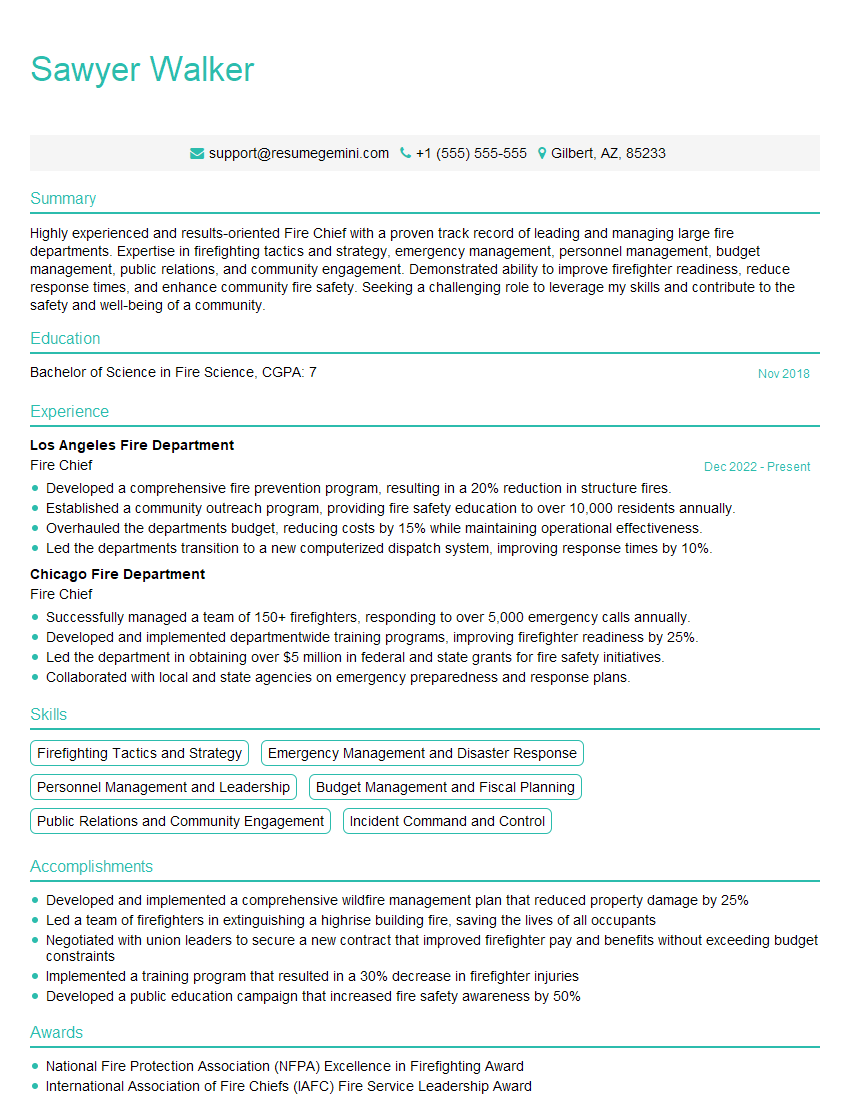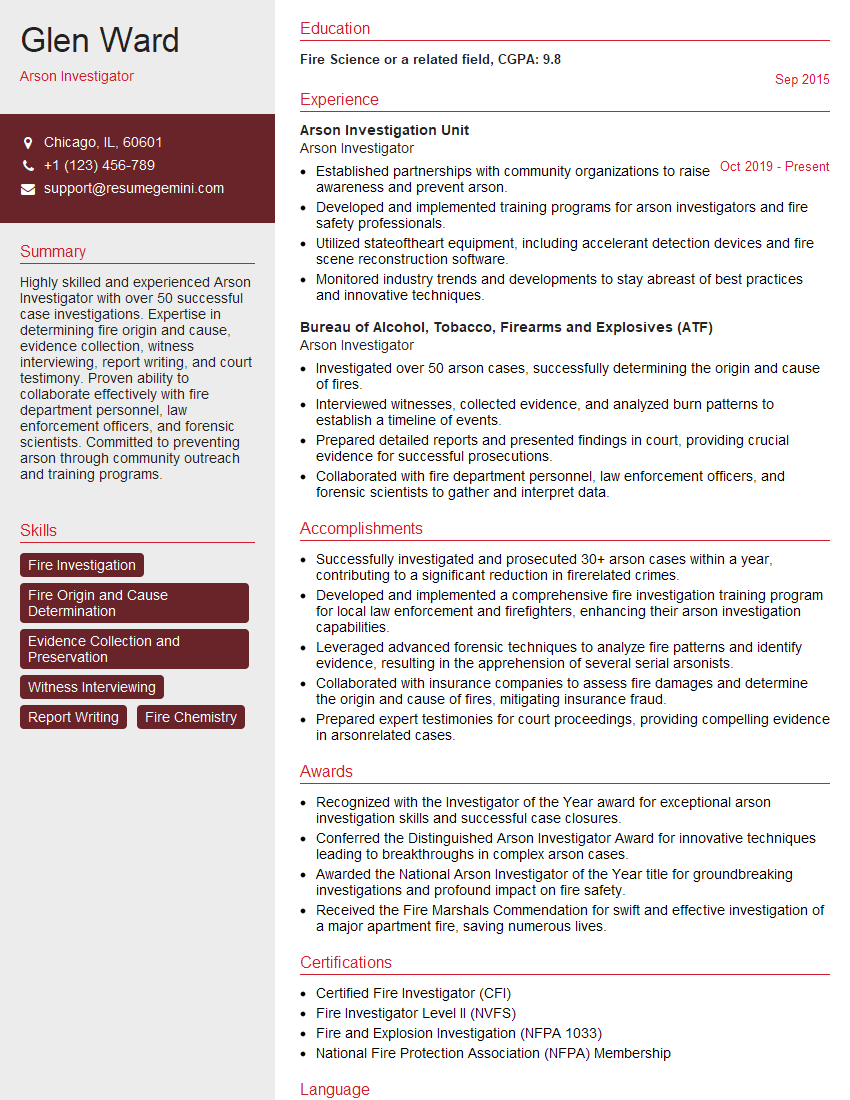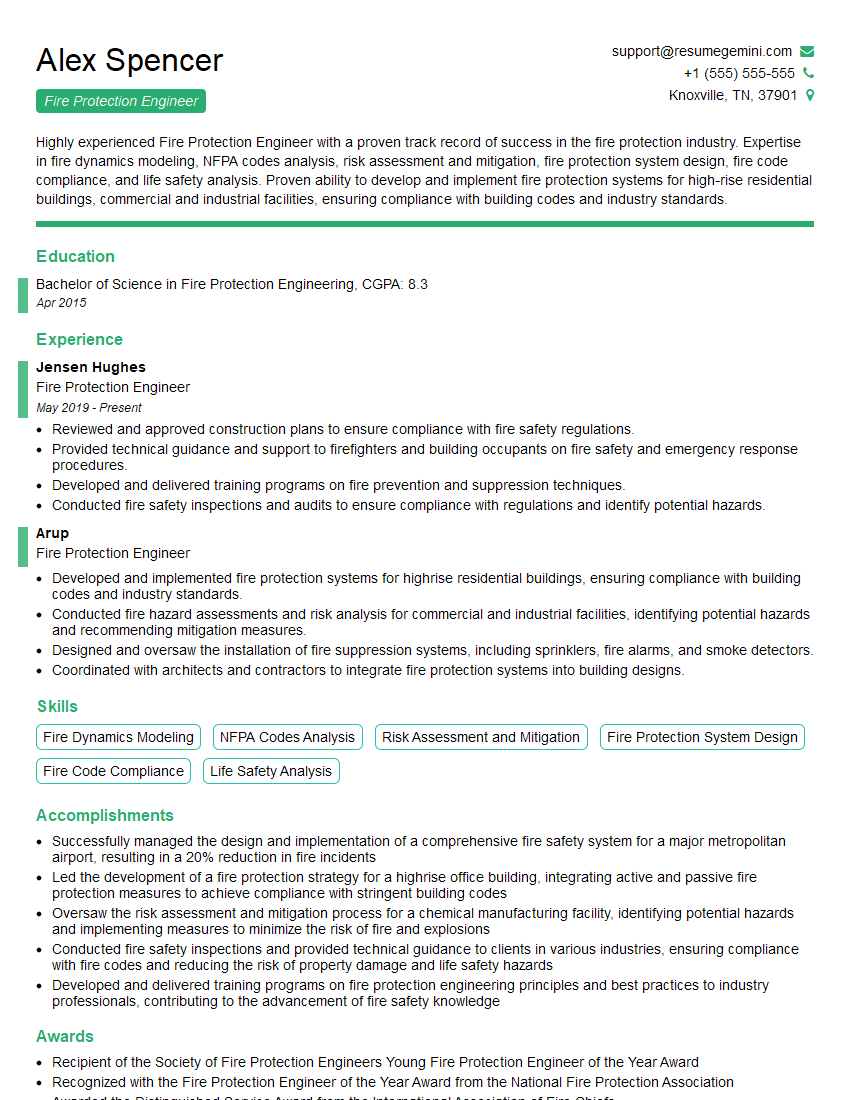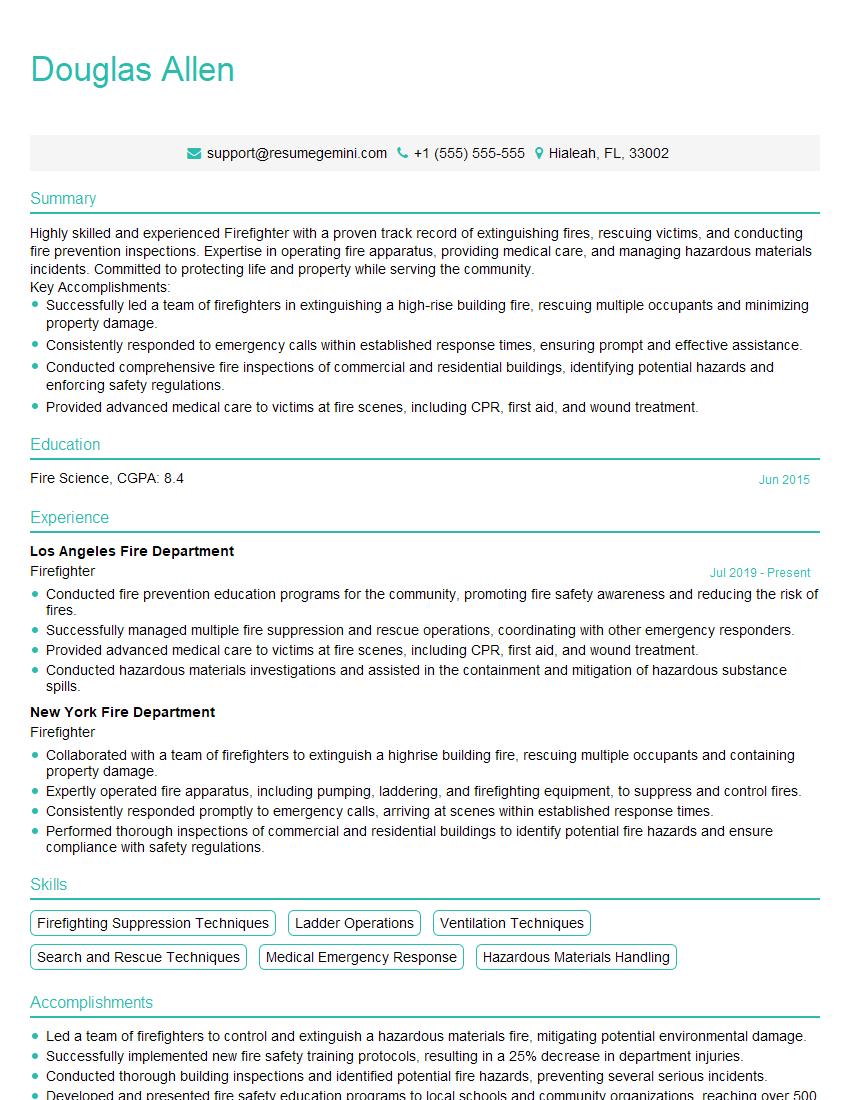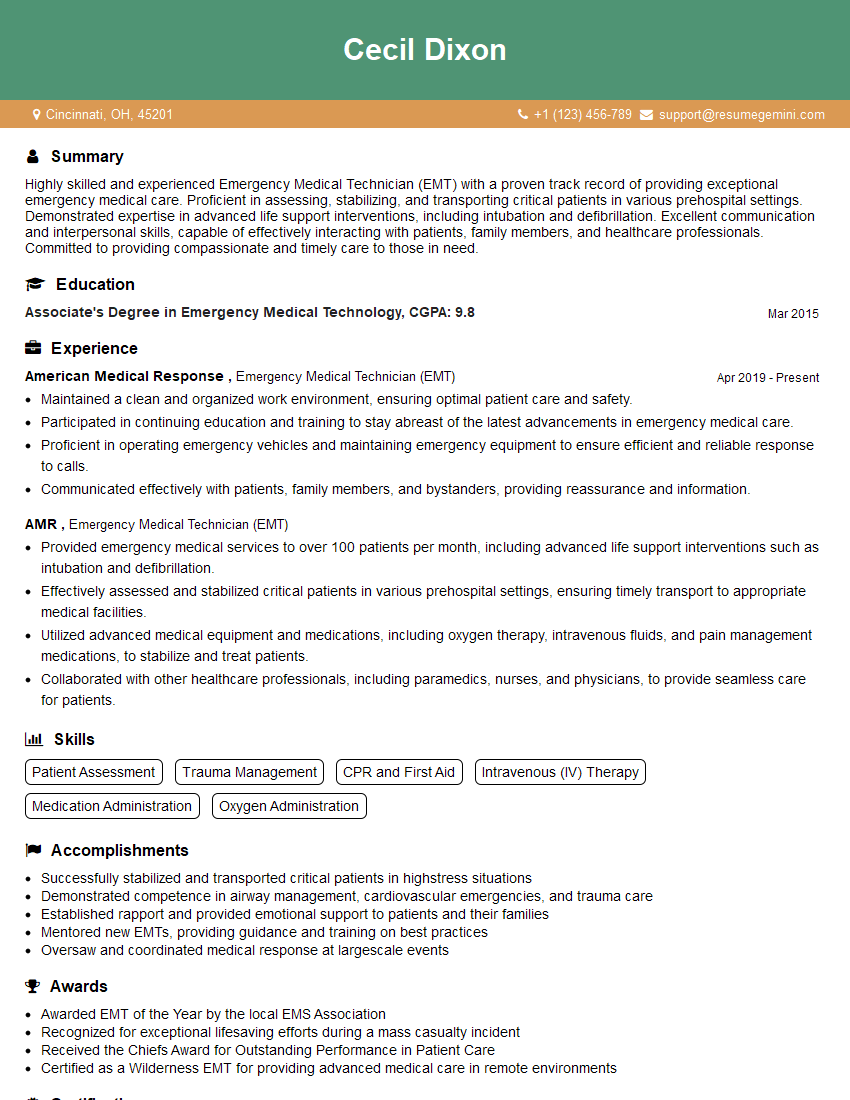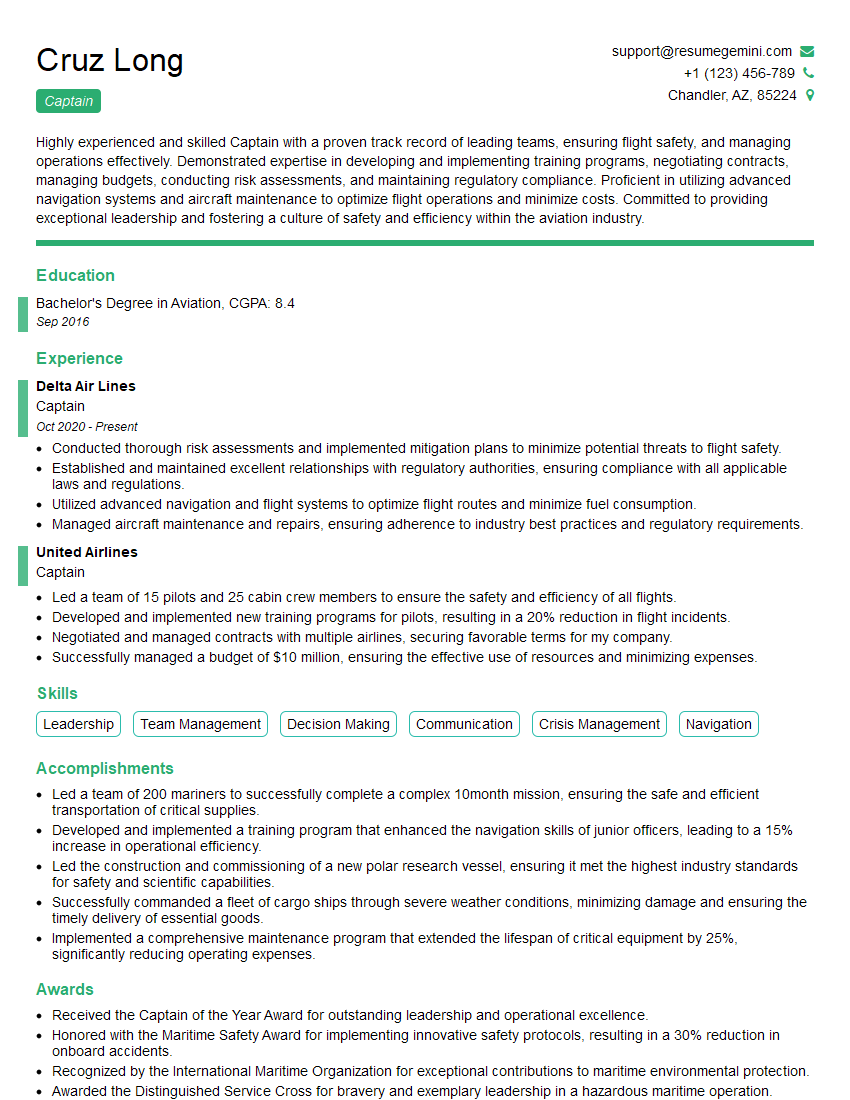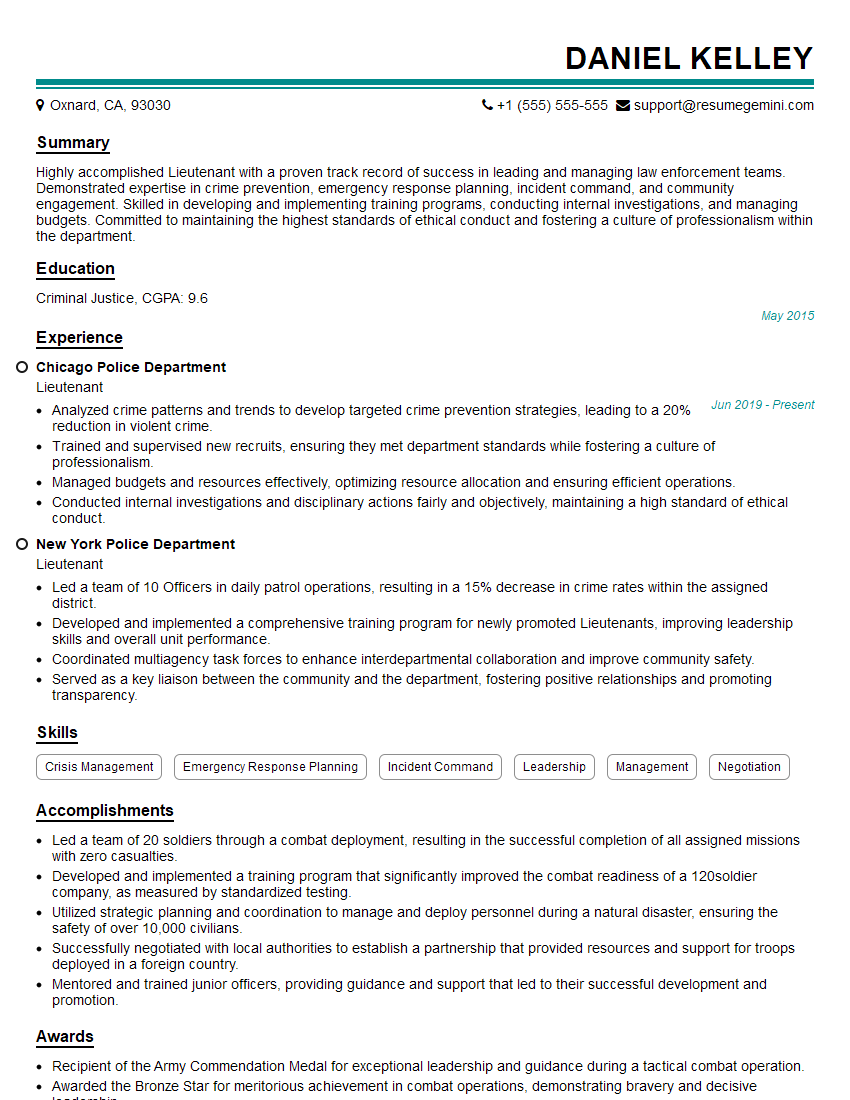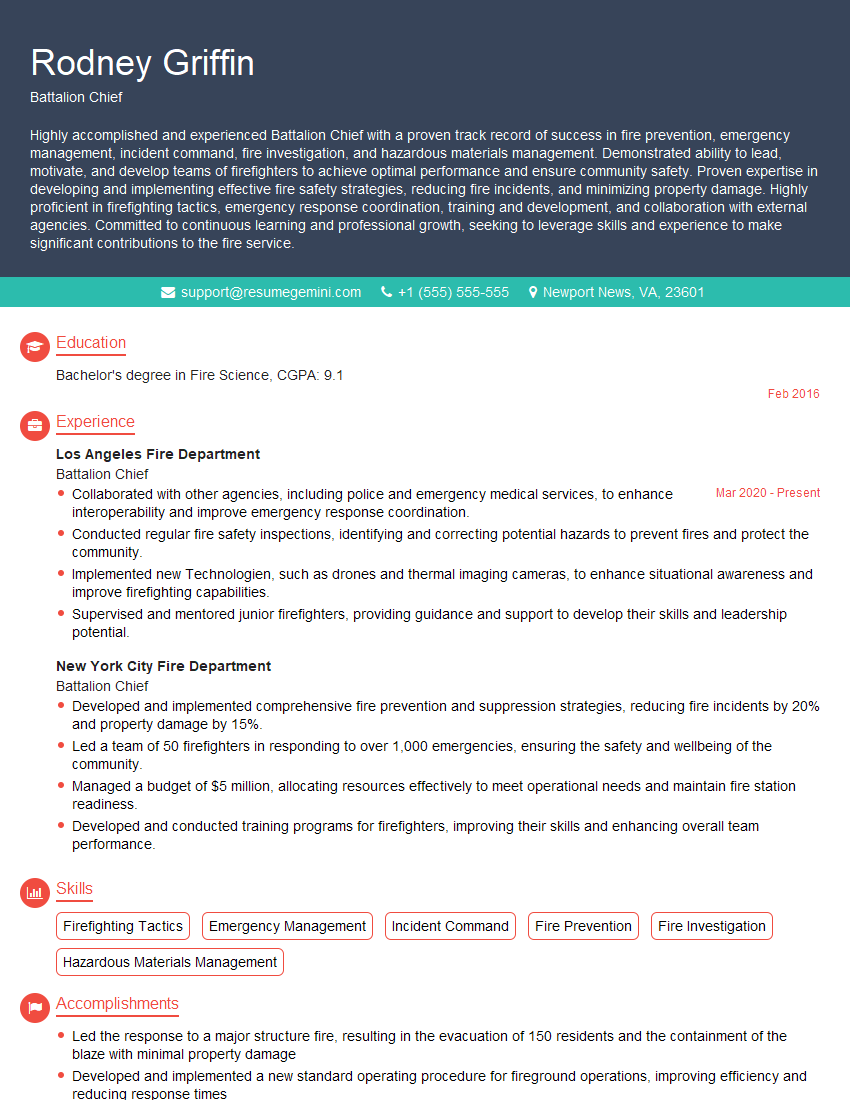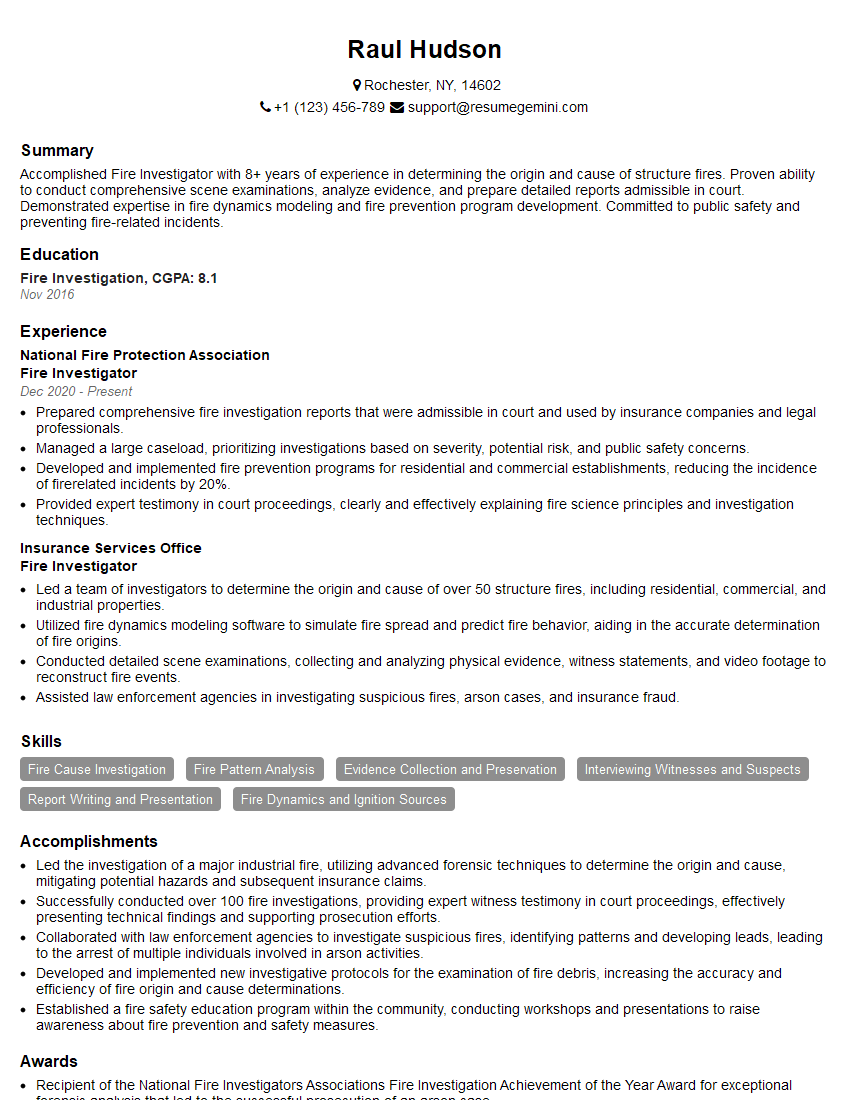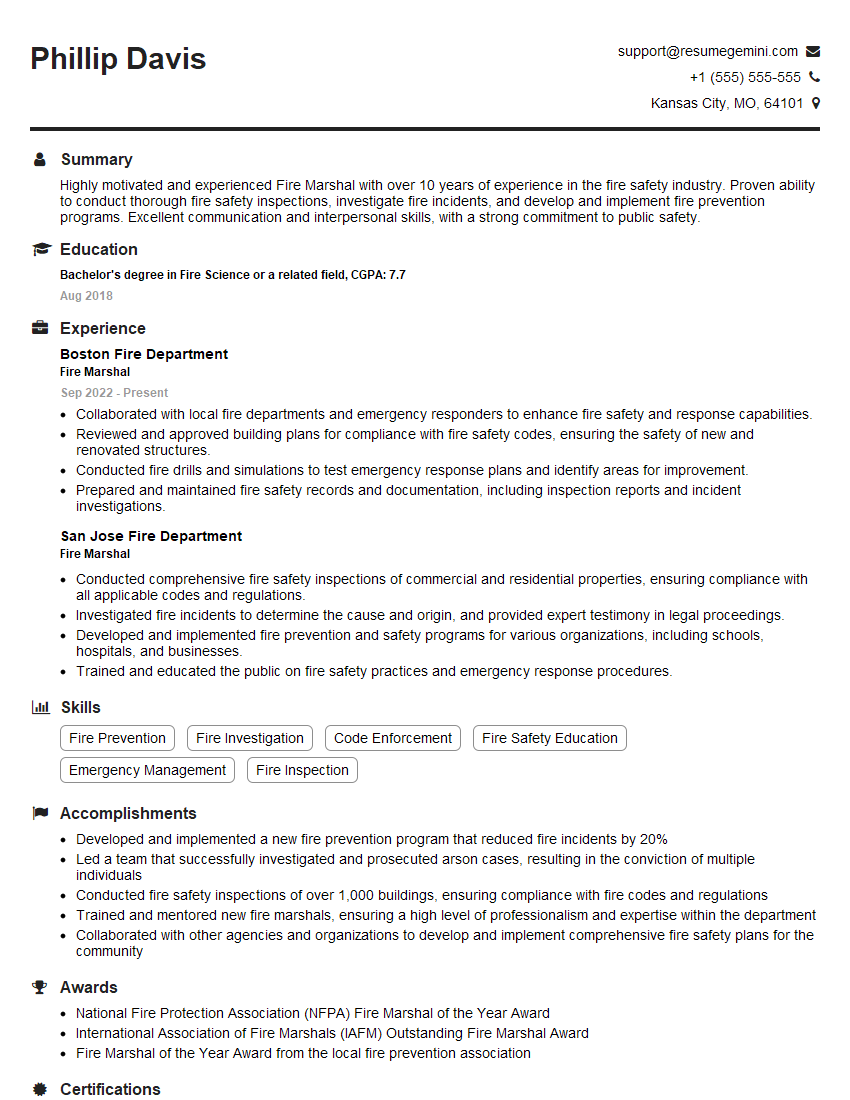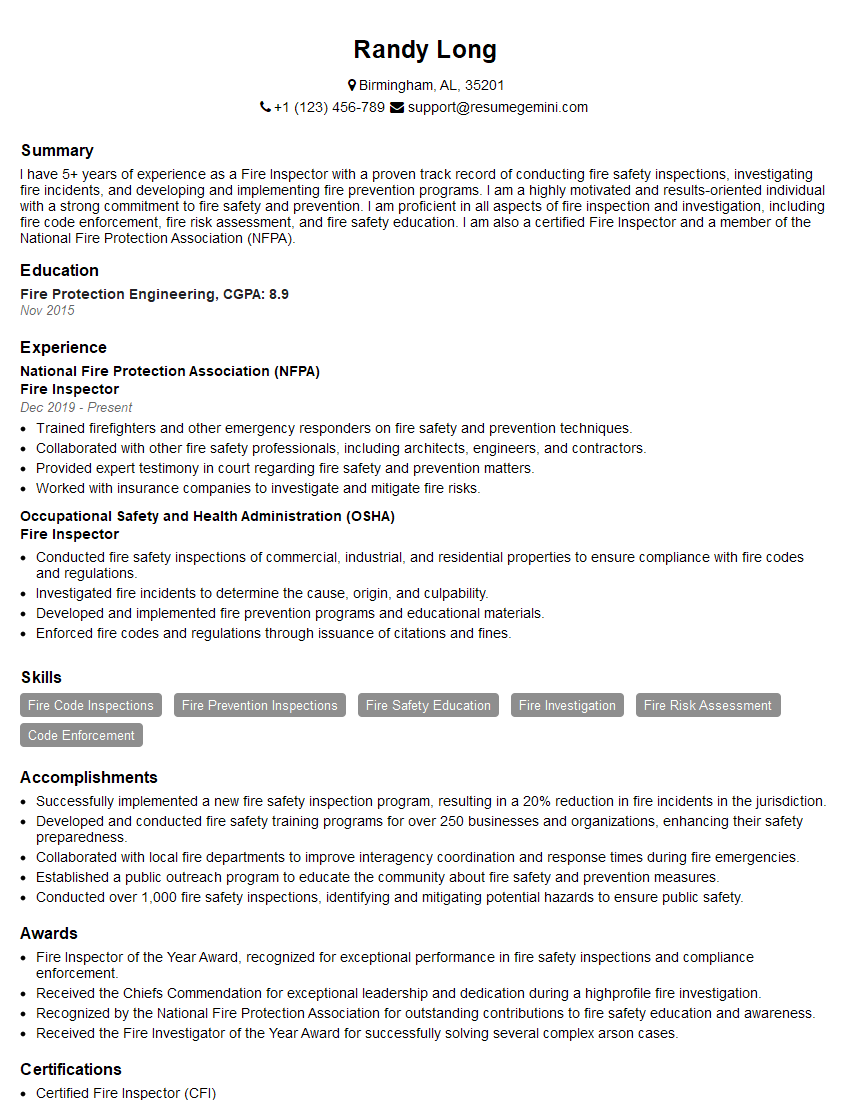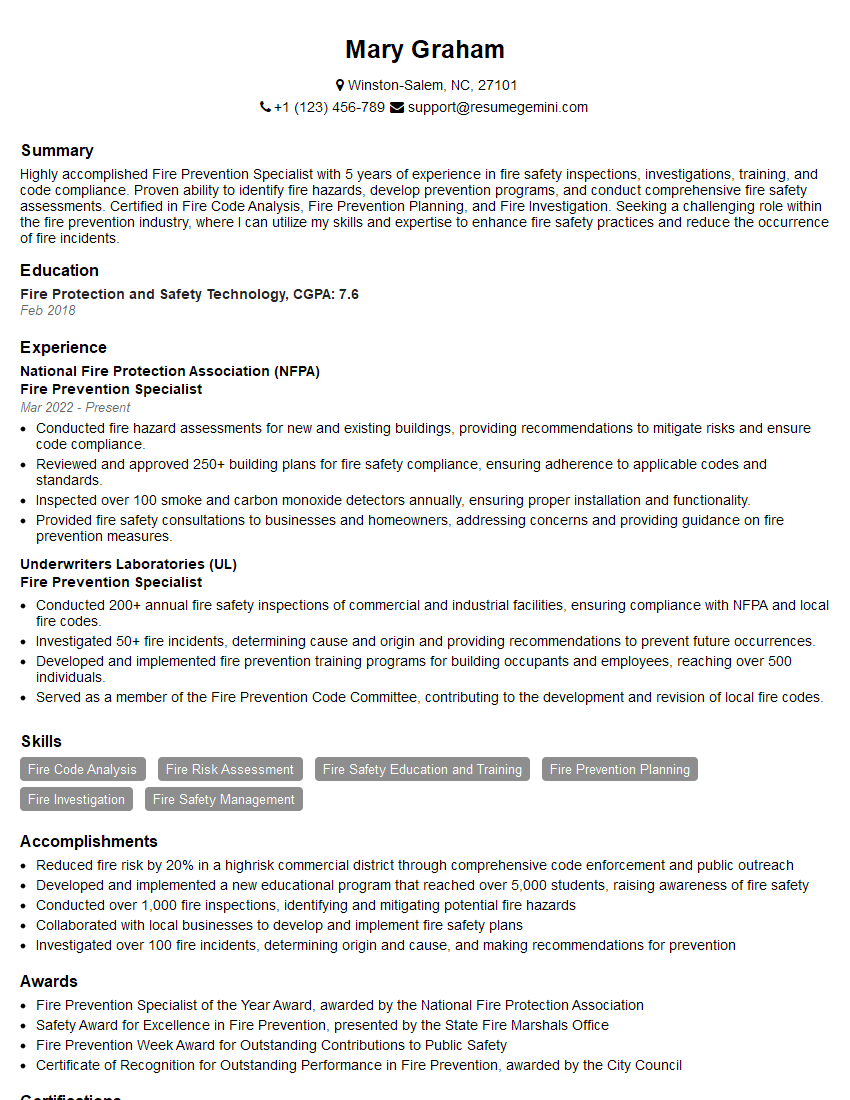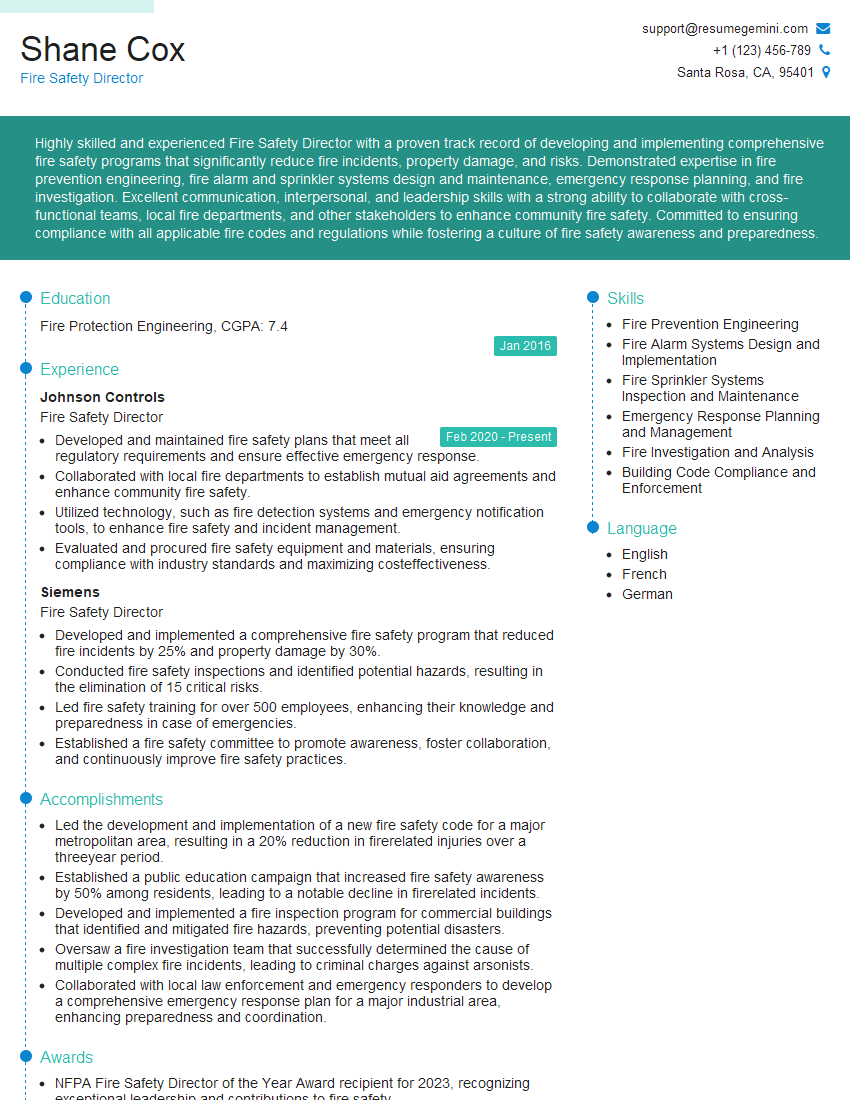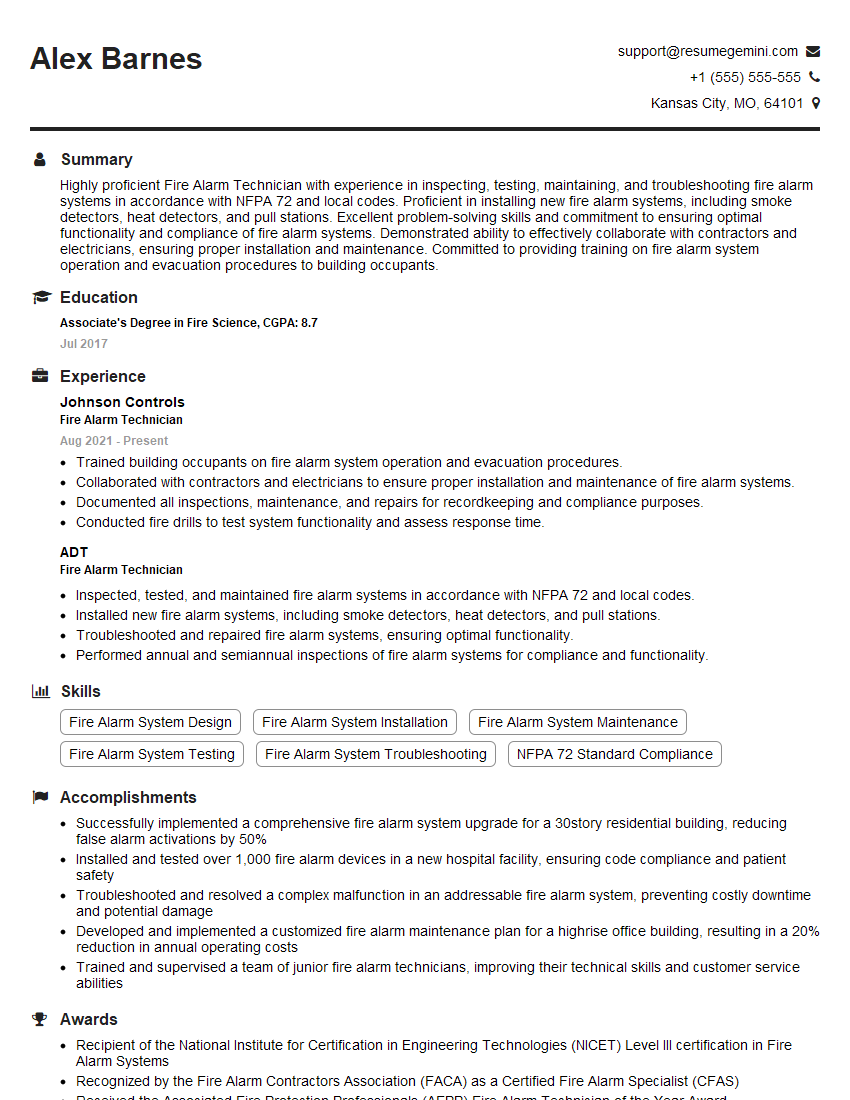Cracking a skill-specific interview, like one for Firefighting and fire prevention techniques, requires understanding the nuances of the role. In this blog, we present the questions you’re most likely to encounter, along with insights into how to answer them effectively. Let’s ensure you’re ready to make a strong impression.
Questions Asked in Firefighting and fire prevention techniques Interview
Q 1. Describe the different classes of fire and the appropriate extinguishing agents for each.
Fires are classified into different categories based on the type of fuel involved, which dictates the most effective extinguishing agent. Understanding this classification is crucial for safe and efficient fire suppression.
- Class A Fires: These involve ordinary combustible materials like wood, paper, cloth, and plastics. They are extinguished by cooling the burning material below its ignition temperature. Water is the primary extinguishing agent for Class A fires.
- Class B Fires: These involve flammable liquids like gasoline, oil, grease, and solvents. They are extinguished by removing the oxygen supply or interrupting the chain reaction. Extinguishing agents include carbon dioxide (CO2), dry chemical powder, and foam. Think of smothering the flames.
- Class C Fires: These fires involve energized electrical equipment. The primary hazard is electrical shock. Never use water on Class C fires! CO2 and dry chemical extinguishers are suitable because they are non-conductive. Once the power is shut off, it becomes a Class A or B fire depending on the material involved.
- Class D Fires: These involve combustible metals such as magnesium, titanium, and sodium. They require specialized extinguishing agents that are designed to cool the metal and prevent oxidation, such as dry powder designed specifically for Class D fires. Using water can actually worsen the situation.
- Class K Fires: These involve cooking oils and fats found in commercial kitchens. Wet chemical extinguishing agents are designed for these fires, as they saponify (create soap) with the cooking oils, thus stopping the fire.
Choosing the wrong extinguisher can be dangerous and ineffective. For instance, using water on a grease fire (Class B) will spread the flames dramatically. Always ensure you select the correct class of extinguisher for the type of fire you are facing.
Q 2. Explain the principles of fire prevention and control.
Fire prevention and control hinge on a multi-pronged approach aiming to minimize the risk of fire and ensure efficient response if one occurs. Prevention is far more effective and cost-efficient than fighting an established fire.
- Fire Prevention: This involves eliminating or minimizing potential ignition sources, removing flammable materials, and implementing preventative measures. For example, regular inspections of electrical systems, proper storage of flammable liquids, and enforcing no-smoking policies in designated areas. Maintaining clear fire exits and ensuring proper ventilation are also crucial.
- Fire Control: This covers the procedures and strategies used to combat an active fire. This includes things like having a well-defined fire safety plan, installing and maintaining fire detection and suppression systems (such as sprinklers and alarms), and conducting regular fire drills. Early detection is absolutely vital in controlling the spread of fire and minimizing damage.
Imagine a building with faulty wiring (prevention failure). A fire starts, but a sprinkler system (control) quickly extinguishes it before significant damage. This shows the synergistic relationship between prevention and control. Both need constant attention.
Q 3. What are the common causes of structural fires?
Structural fires, those affecting buildings, have a variety of causes. Some are accidental, while others are the result of arson or negligence.
- Heating Equipment: Malfunctioning furnaces, improperly installed heaters, and misuse of space heaters are common culprits. Think of a furnace that overheats due to lack of maintenance.
- Cooking Equipment: Unattended cooking, grease fires, and malfunctioning kitchen appliances account for many fires. Leaving a stove on unattended is a classic example.
- Electrical Malfunctions: Overloaded circuits, faulty wiring, and damaged electrical appliances are frequent causes. Think about an old appliance sparking due to frayed wiring.
- Smoking Materials: Discarded cigarettes, particularly in furniture or bedding, are a leading cause of home fires. A smoldering cigarette dropped on a couch can easily ignite upholstery.
- Arson: Deliberately set fires are unfortunately a significant cause, particularly in abandoned buildings or for malicious purposes.
- Lightning Strikes: In some cases, particularly during thunderstorms, lightning can strike buildings, causing significant fire hazards.
Understanding these common causes is fundamental in enacting preventative measures. Regular maintenance checks, responsible use of appliances, and fire-safe building materials all play an important role in reducing the risk of structural fires.
Q 4. How do you conduct a fire safety inspection?
A fire safety inspection is a systematic evaluation of a building or premises to identify potential fire hazards and ensure compliance with fire safety regulations. This involves a thorough, methodical approach.
- Preparation: Review building plans, occupancy permits, and existing fire safety documentation.
- Exterior Inspection: Check for proper access for fire trucks, clear fire escapes, and working exterior lighting. Examine building materials for fire resistance.
- Interior Inspection: Verify the functionality of fire alarms, sprinklers, and extinguishers. Inspect exits and hallways for obstructions. Check for adequate fire-resistant construction materials.
- Electrical Systems: Inspect wiring for damage, overloaded circuits, and proper grounding. Assess the condition of electrical appliances.
- Heating Systems: Verify the maintenance of heating units and chimneys. Check for proper clearance around heating equipment.
- Storage of Flammable Materials: Assess the proper storage and handling of flammable and combustible materials. Note any violations.
- Emergency Procedures: Verify the availability and comprehensiveness of emergency plans, evacuation routes, and employee training on fire safety procedures.
- Documentation: Record all findings and deficiencies, including photographs and detailed descriptions. Provide recommendations for corrective actions.
A thorough inspection isn’t just about finding problems; it’s about creating a safer environment. A proactive approach can significantly reduce the risk of a devastating fire.
Q 5. What are the key components of a fire alarm system?
A fire alarm system is a network of interconnected devices designed to detect and signal the presence of fire. A comprehensive system has several essential components working together.
- Smoke Detectors: These sense smoke particles in the air, triggering an alarm. Ionization and photoelectric detectors are common types, each sensitive to different types of smoke.
- Heat Detectors: These respond to changes in temperature, particularly rapid rises. They are often used in areas where smoke detectors might be less effective, such as kitchens.
- Control Panel: The central unit receives signals from detectors, activates alarms, and may interface with other systems like sprinklers.
- Notification Appliances: These are the audible and visual alarms that alert occupants of a fire. These can include horns, bells, strobe lights, and voice announcements.
- Power Supply: The system must have a reliable power source, including a backup battery system in case of power failure. This ensures the alarm continues to function even during a power outage.
Regular testing and maintenance are crucial. A malfunctioning alarm is worse than no alarm at all. Imagine a fire starting undetected due to a faulty detector — the consequences can be catastrophic.
Q 6. Describe the procedures for evacuating a building during a fire.
Evacuation procedures are critical in minimizing casualties during a fire. A well-defined and practiced plan is essential.
- Alarm Activation: Upon discovering a fire or hearing the alarm, activate the nearest alarm pull station immediately.
- Account for Everyone: Ensure all occupants are aware of the fire and are evacuating. Designate a person to check rooms or areas.
- Designated Exit Routes: Utilize the pre-determined and clearly marked escape routes. Avoid elevators, as these can malfunction or become trapped.
- Stay Low to the Ground: Smoke rises, so staying low to the ground improves visibility and helps you breathe easier. Crawl if necessary.
- Do Not Re-enter: Once outside, stay away from the building and assemble at a designated assembly point. Never go back inside for personal belongings.
- Contact Emergency Services: Someone from outside the building must contact the fire department and report the fire, including the building’s location and address.
Regular fire drills are essential to ensure everyone understands the procedures and knows their responsibilities. A practiced evacuation is much more efficient and safer than one done in a panic. Having a clear plan, and practicing that plan, makes a big difference.
Q 7. Explain the importance of personal protective equipment (PPE) in firefighting.
Personal Protective Equipment (PPE) is crucial for firefighters to mitigate risks associated with fire suppression. It protects them from heat, flames, smoke inhalation, and other hazards.
- Structural Firefighting Gear: This includes a self-contained breathing apparatus (SCBA) to provide breathable air in smoky environments, a protective helmet, turnout coat and pants made of fire-resistant materials to protect against burns and heat, gloves, and boots offering heat and cut protection.
- Eye Protection: Safety glasses or face shields protect against flying debris and intense heat.
- Hearing Protection: Earplugs or muffs protect against the loud noises associated with firefighting operations.
- Other Protective Gear: Depending on the specific situation, this may include specialized equipment like thermal imaging cameras, rescue tools, or protective suits for hazardous materials incidents.
Without proper PPE, firefighters would be at extreme risk. Imagine tackling a raging fire without proper breathing apparatus or thermal protection — the consequences would be severe. PPE is not just a safety measure; it is a lifeline, ensuring firefighters can do their jobs effectively and safely return home.
Q 8. How do you use a fire extinguisher effectively?
Using a fire extinguisher effectively involves remembering the acronym PASS: Pull the pin, Aim at the base of the fire, Squeeze the lever, and Sweep from side to side. Before attempting to use an extinguisher, ensure your escape route is clear. Think of it like this: you wouldn’t charge into a burning building without a plan to get out; the same applies to using an extinguisher.
Pulling the pin removes the safety mechanism. Aiming at the base ensures you’re attacking the fuel source, not just the flames. Squeezing the lever releases the extinguishing agent. Sweeping from side to side ensures even coverage and prevents reignition. Different extinguishers contain different agents (water, CO2, foam, dry chemical) – each suited for specific fire classes (A, B, C, D, K). Knowing your extinguisher’s type and rating is crucial for safe and effective use. If the fire is too large or spreading rapidly, evacuate immediately and call emergency services.
Q 9. What are the signs of potential arson?
Signs of potential arson are often subtle but can be highly suggestive. They often involve unusual circumstances surrounding the fire’s origin. For example, multiple points of origin suggest deliberate setting, while the presence of accelerants like gasoline or kerosene indicates premeditation. Other suspicious signs include evidence of forced entry, unusual behavior by individuals near the scene before or after the fire, a pattern of previous fires at the same location or associated with the same individual, and financial difficulties or insurance claims preceding the fire. Furthermore, a fire occurring in an unoccupied building or during unusual hours should raise suspicion. Detectives investigate these indicators, often using accelerant-detecting canines and lab analysis of fire debris.
Q 10. What is the role of a fire marshal in emergency response?
A fire marshal plays a critical role during emergency response, primarily focused on ensuring the safety of personnel and the effective control of the incident. Their responsibilities include overseeing the evacuation process, coordinating firefighting efforts with responding units, managing the scene, identifying potential hazards, and investigating the cause of the fire post-incident. They often act as a liaison between the fire department and building management or property owners. Think of them as the on-scene coordinator ensuring a smooth and efficient response, safeguarding lives and minimizing property damage. Following the incident, they contribute significantly to the investigation and the preparation of official reports. Their expertise in fire safety codes and regulations is invaluable.
Q 11. Describe different types of fire suppression systems.
Various fire suppression systems exist, each designed for different applications and fire types. These include:
- Water-based systems: The most common, effective for Class A fires (ordinary combustibles). They use sprinklers or hose systems.
- Foam systems: Suitable for Class A and B fires (flammable liquids). They create a blanket to smother the flames.
- Carbon dioxide (CO2) systems: Effective for Class B and C fires (electrical equipment). They displace oxygen, extinguishing the fire.
- Dry chemical systems: Suitable for Class A, B, and C fires. They interrupt the chemical chain reaction.
- Wet chemical systems: Specifically designed for Class K fires (cooking oils and fats).
- Clean agent systems: Environmentally friendly alternatives that don’t leave residue, often used in sensitive environments like data centers.
Q 12. What are the limitations of each fire suppression system?
Each fire suppression system has limitations:
- Water-based systems: Can cause water damage, are ineffective for Class B and C fires, and may conduct electricity.
- Foam systems: Can be messy and environmentally unfriendly, less effective on deep-seated fires.
- CO2 systems: Can displace oxygen, posing a hazard to occupants, ineffective on Class A fires.
- Dry chemical systems: Can create low visibility, corrosive residue, and can damage equipment.
- Wet chemical systems: Limited to Class K fires.
- Clean agent systems: Can be expensive, and some may have health effects with high concentrations.
Understanding these limitations is crucial for selecting the appropriate system for a given environment.
Q 13. Explain the concept of fire triangles and tetrahedrons.
The fire triangle illustrates the three elements needed for combustion: heat, fuel, and oxygen. Remove any one, and the fire goes out. Think of it like a three-legged stool – if one leg is missing, the stool collapses. The fire tetrahedron expands on this by adding a fourth element: a self-sustaining chemical chain reaction. This is crucial because it explains how fires can continue to burn even after the initial heat source is removed. The chain reaction is the ongoing process of combustion, and interrupting it is key to extinguishing the fire.
Q 14. How do you assess the structural integrity of a building during a fire?
Assessing structural integrity during a fire is a complex process requiring experience and careful observation. Factors considered include the type of construction materials, the extent and location of the fire, the duration of the fire, and the presence of water damage. Visible signs of weakness like bowing walls, cracked foundations, or collapsing ceilings are clear indications of structural compromise. The use of thermal imaging cameras can help detect areas of extreme heat weakening the structure internally. Experienced firefighters often use a combination of visual inspection, knowledge of the building’s construction, and sometimes specialized equipment like load-bearing capacity sensors. Safety is paramount; if there’s doubt about the structural integrity, the area must be evacuated, and access restricted until a structural engineer can assess the situation.
Q 15. Describe the proper techniques for ventilation during firefighting.
Proper ventilation during firefighting is crucial for firefighter safety and effective fire suppression. It involves strategically removing smoke, heat, and toxic gases from a burning structure to improve visibility, reduce the risk of flashover (a sudden, intense increase in fire intensity), and create a safer environment for both firefighters and occupants. Techniques vary depending on the type of building and the fire’s location but generally fall into two categories: positive-pressure ventilation and negative-pressure ventilation.
Positive-Pressure Ventilation: This method involves using powerful fans to force fresh air into the building, pushing the smoke and heat out through existing openings like windows and doors. Think of it like blowing a strong wind through the building. This is often used in larger structures where controlling the airflow is important. It’s especially effective in removing smoke from upper floors.
Negative-Pressure Ventilation: This involves using fans to draw smoke and heat *out* of the building, creating a pressure difference that pulls fresh air in. This technique is typically employed using exhaust fans placed at strategic points where the smoke is concentrated. It’s crucial to ensure adequate fresh air intake to avoid creating a dangerous vacuum effect. Imagine using a vacuum cleaner to suck the smoke out.
Regardless of the method, careful consideration of wind direction, building construction, and the fire’s location are essential. Improper ventilation can spread the fire or create dangerous conditions for firefighters. For instance, introducing fresh oxygen into a smoldering fire without proper control can lead to a sudden resurgence of flames. A coordinated effort between fire crews using both positive and negative pressure ventilation is often necessary to achieve effective and safe ventilation.
Career Expert Tips:
- Ace those interviews! Prepare effectively by reviewing the Top 50 Most Common Interview Questions on ResumeGemini.
- Navigate your job search with confidence! Explore a wide range of Career Tips on ResumeGemini. Learn about common challenges and recommendations to overcome them.
- Craft the perfect resume! Master the Art of Resume Writing with ResumeGemini’s guide. Showcase your unique qualifications and achievements effectively.
- Don’t miss out on holiday savings! Build your dream resume with ResumeGemini’s ATS optimized templates.
Q 16. What are the hazards associated with smoke inhalation?
Smoke inhalation presents serious hazards, potentially leading to immediate and long-term health problems. The dangers are multifaceted:
Oxygen Deprivation: Smoke displaces oxygen, leading to hypoxia (lack of oxygen in the body), which can cause disorientation, unconsciousness, and even death.
Toxic Gas Exposure: Smoke contains a cocktail of toxic gases, including carbon monoxide (CO), hydrogen cyanide (HCN), and nitrogen dioxide (NO2). CO binds to hemoglobin in the blood, preventing oxygen transport, while HCN interferes with cellular respiration. NO2 can severely damage the lungs.
Thermal Injury: Superheated gases in smoke can cause burns to the airways, lungs, and throat.
Particulate Matter: Smoke contains fine particulate matter that can irritate and inflame the respiratory system, leading to bronchitis, pneumonia, and other respiratory illnesses. Long-term effects can include chronic obstructive pulmonary disease (COPD).
The severity of smoke inhalation injury depends on factors like the concentration of toxic gases, duration of exposure, and the individual’s health. Immediate medical attention is vital for anyone suspected of smoke inhalation.
Q 17. How do you handle hazardous materials incidents?
Handling hazardous materials (HazMat) incidents requires a systematic and cautious approach, prioritizing the safety of responders and the public. The response involves several key steps:
Identification and Assessment: Quickly identify the hazardous material involved using available resources like placards, labels, shipping papers, and specialized detection equipment. Assess the potential hazards – flammability, toxicity, reactivity, corrosivity – and the extent of the release.
Containment and Control: Establish a perimeter to control access and prevent further exposure. Use appropriate containment methods, such as dams, dikes, or absorbent materials, to prevent the spread of the hazardous substance. This often requires specialized equipment and personnel trained in HazMat handling.
Decontamination: Develop and implement a decontamination plan to remove the hazardous material from affected personnel and equipment. This may involve washing, rinsing, or using specialized decontamination solutions. Decontamination zones are established to systematically remove contamination.
Notification and Communication: Immediately notify relevant authorities (e.g., fire department, police, emergency medical services, environmental protection agency) and inform the public about potential risks and evacuation procedures if necessary.
Cleanup and Remediation: After the immediate threat has been neutralized, initiate the cleanup and remediation process to restore the affected area to a safe condition. This might involve removing contaminated soil, water, or other materials.
HazMat incidents require specialized training, equipment, and procedures. Improper handling can lead to serious injuries or environmental damage. For example, a mishandled chemical spill could lead to widespread contamination of a water source. Always rely on established protocols and seek expert advice from HazMat teams.
Q 18. What is your understanding of NFPA standards?
The National Fire Protection Association (NFPA) develops and publishes widely adopted fire safety standards, codes, and guidelines. These standards cover a broad range of topics, from fire prevention and protection systems to emergency response and training. Understanding NFPA standards is fundamental to the firefighting profession and building safety. These standards are regularly updated based on research and advances in fire science and technology.
Examples of key NFPA standards include:
NFPA 101: Life Safety Code: This is a comprehensive standard addressing life safety requirements for buildings and facilities.
NFPA 70: National Electrical Code (NEC): Focuses on electrical safety in buildings.
NFPA 72: National Fire Alarm and Signaling Code: Establishes standards for fire alarm systems.
NFPA 1001: Standard for Fire Fighter Professional Qualifications: Sets minimum job performance requirements for firefighters.
Adherence to NFPA standards is crucial for ensuring the safety of buildings and occupants and for creating a consistent framework for fire protection and response across jurisdictions. It’s a vital part of professional practice.
Q 19. Explain the importance of fire safety training and education.
Fire safety training and education are paramount in preventing fires and mitigating their consequences. It empowers individuals and organizations to take proactive measures to reduce fire risks and ensure a safe environment.
The importance is two-fold:
Prevention: Training programs educate individuals about fire hazards, safe practices, and preventative measures. This includes topics such as proper electrical usage, safe storage of flammable materials, and the importance of working smoke alarms. For example, teaching employees in a factory about the proper use of welding equipment can significantly reduce the risk of fire.
Response: Training provides essential knowledge and skills for responding to a fire effectively and safely. This involves understanding evacuation procedures, using fire extinguishers, and following emergency response protocols. Knowing what to do in a fire, like properly using a fire extinguisher or following an evacuation plan, dramatically increases the chance of survival and limits property damage.
Regular training updates and drills reinforce learned practices. Education programs, tailored to specific audiences (e.g., children, seniors, businesses), raise awareness and encourage the adoption of fire-safe behaviors within communities. The cumulative effect of comprehensive training and education significantly reduces the likelihood and severity of fire incidents.
Q 20. How do you develop a fire safety plan for a building?
Developing a comprehensive fire safety plan is a critical step in protecting a building and its occupants. It’s not a one-size-fits-all process but rather a tailored approach that takes into account the building’s unique characteristics, occupancy type, and potential hazards. A thorough plan includes:
Hazard Assessment: Identify potential fire hazards within the building (e.g., flammable materials, electrical systems, cooking appliances). This is the foundation upon which the entire plan rests.
Emergency Action Plan (EAP): Outline procedures for reporting fires, evacuating the building, and assembling at designated safe locations. Clearly define roles and responsibilities for staff and occupants.
Fire Prevention Measures: Implement measures to prevent fires, including regular inspections of fire protection systems (sprinklers, fire alarms), proper storage of flammable materials, and regular maintenance of electrical systems. A preventative approach avoids fires before they start.
Fire Suppression Systems: Ensure that adequate fire suppression systems (e.g., sprinklers, fire extinguishers) are installed, maintained, and regularly inspected. These act as the first line of defense if a fire does occur.
Training and Drills: Conduct regular fire safety training for all occupants, including familiarization with the EAP and the proper use of fire safety equipment. Regular drills reinforce procedures and ensure preparedness.
Documentation: Maintain thorough documentation of the fire safety plan, including hazard assessments, maintenance records, and training logs. Good documentation is crucial for auditing and demonstrating compliance.
The plan should be regularly reviewed and updated to reflect any changes in the building’s use or occupancy. Consider involving stakeholders, including building management, occupants, and fire safety professionals in the development and implementation of the plan.
Q 21. What is your experience with fire investigation techniques?
Fire investigation techniques are crucial in determining the cause and origin of a fire, providing critical information for prevention and legal purposes. A systematic approach is vital:
Scene Preservation and Security: The first step is securing the scene to prevent contamination or tampering with evidence. This includes controlling access to the area.
Preliminary Assessment: Initial observations of the scene, including the extent and pattern of damage, provide clues about the fire’s progression. Note points of origin, the presence of accelerants, and any unusual features.
Evidence Collection: Collect physical evidence systematically, documenting its location and chain of custody. This can include debris samples, electrical components, and potentially accelerant residue. Proper evidence collection is key for legal validity.
Witness Interviews: Gathering information from witnesses can provide valuable insights into events preceding and during the fire.
Scientific Analysis: Laboratory analysis of collected samples can confirm the presence of accelerants or other substances, aiding in determining the cause of ignition.
Report Writing: A comprehensive report summarizes the investigation’s findings, presenting evidence and concluding on the fire’s origin and cause.
Experience in fire investigation involves a deep understanding of fire dynamics, material science, and investigative techniques. It often requires specialized training and certification. For example, identifying burn patterns on walls and floors can indicate the direction of fire spread and point to a probable ignition source. Rigorous investigation ensures accountability and informs strategies for preventing future fires.
Q 22. Describe a challenging fire scenario you have encountered and how you responded.
One of the most challenging fire scenarios I encountered involved a large-scale warehouse fire. The building was a multi-level structure containing highly flammable materials, including pallets of chemicals and textiles. The fire had already gained significant momentum by the time we arrived, with heavy smoke obscuring visibility and creating intense heat. This presented several immediate challenges: rapid fire spread, risk of structural collapse, and potential for hazardous material release.
Our response involved a multi-pronged approach. First, we established a command structure and began a coordinated attack on the fire using multiple hose lines, focusing on suppression and containment. Simultaneously, a rescue team searched for any potential trapped individuals. We employed defensive firefighting tactics initially, given the intensity and unpredictable nature of the blaze, prioritizing the safety of our personnel. As conditions improved, we transitioned to more offensive tactics, working our way into the building to extinguish hotspots. Regular safety checks and communication were paramount. We utilized thermal imaging cameras to identify hidden fire pockets and assess structural integrity, ensuring the safety of firefighters during interior operations. The successful containment and eventual extinguishing of the fire was a testament to effective teamwork, rapid decision-making, and adherence to established safety protocols.
Q 23. How do you maintain your physical fitness for demanding firefighting work?
Maintaining peak physical fitness is absolutely crucial for firefighters. The job demands incredible strength, endurance, and agility. My fitness regimen is rigorous and multifaceted. It includes:
- Cardiovascular training: I regularly engage in activities like running, cycling, and swimming to build stamina and endurance, crucial for navigating intense firefighting situations.
- Strength training: This focuses on building upper and lower body strength through weightlifting and calisthenics. This is essential for carrying heavy equipment and overcoming obstacles.
- Flexibility and mobility exercises: Yoga and stretching help to improve range of motion and prevent injuries. Flexibility is critical for maneuvering in tight spaces.
- Specialized training: We regularly participate in simulations and training exercises that involve carrying equipment, climbing stairs, and performing rescue techniques under stressful conditions, mirroring real-world scenarios.
Regular medical check-ups are also part of this process to monitor fitness levels and identify any potential health issues.
Q 24. Describe your experience with teamwork and communication in a high-pressure environment.
Teamwork and clear communication are the cornerstones of successful firefighting. In high-pressure situations, effective communication becomes even more critical. I’ve experienced numerous instances where seamless coordination among team members was the difference between a successful outcome and a potential disaster.
For instance, during a multi-alarm structure fire, the incident commander’s clear and concise directions ensured that every team knew their roles and responsibilities. The use of standard fireground terminology and radio communication prevented confusion and streamlined operations. Effective communication involves clear, concise messages delivered efficiently, as well as active listening to understand the situation fully. Trust among team members, fostered through regular training and mutual respect, is also paramount. We conduct frequent drills and practice scenarios to enhance our teamwork and communication skills under pressure.
Q 25. How do you handle stress and pressure during emergency situations?
Emergency situations inevitably bring stress and pressure. Managing this is crucial for maintaining effectiveness and safety. My approach involves a combination of techniques:
- Training and preparation: Thorough training reduces uncertainty and builds confidence, helping to mitigate stress. Knowing the procedures and having practiced them repeatedly allows for better decision-making under pressure.
- Mindfulness and breathing techniques: In stressful situations, I consciously focus on my breathing to calm my nervous system. This helps to clear my head and improve my focus.
- Team support: The camaraderie and support of my team are invaluable. Open communication and mutual support create a strong sense of trust and resilience.
- Post-incident debriefing: These sessions allow us to process the events, identify areas for improvement, and provide emotional support to team members.
Maintaining a healthy lifestyle outside of work, through proper rest and recreation, is also essential for stress management. Regular exercise, a balanced diet, and sufficient sleep are vital for both physical and mental well-being.
Q 26. What are your leadership skills and how would you use them in a fire service setting?
My leadership style is collaborative and supportive. I believe in empowering team members and fostering a climate of open communication and mutual respect. In a fire service setting, this translates to:
- Clear and concise communication: Providing clear and concise instructions, ensuring everyone understands their roles and responsibilities.
- Delegation of tasks: Assigning tasks based on individual skills and experience, promoting teamwork and efficiency.
- Decision-making under pressure: Making informed, timely decisions based on the available information, while prioritizing safety.
- Mentorship and training: Guiding and mentoring junior firefighters, sharing my knowledge and experience to improve their skills.
- Promoting safety: Establishing and maintaining a strong emphasis on safety procedures and protocols, ensuring the well-being of the team.
I believe effective leadership in firefighting is about leading by example, building trust, and ensuring the safety and well-being of the entire team.
Q 27. Describe your understanding of building codes and regulations related to fire safety.
Understanding building codes and regulations related to fire safety is fundamental to our work. This knowledge allows us to assess risks, predict fire behavior, and develop effective strategies for fire suppression and prevention. My understanding encompasses a wide range of areas, including:
- Building construction materials: Understanding how different materials react to fire and the potential hazards associated with them.
- Fire detection and suppression systems: Knowing how these systems work and their limitations, allowing for efficient use during emergencies.
- Means of egress: Understanding the requirements for safe evacuation routes, identifying potential obstacles, and ensuring a safe exit for occupants.
- Fire safety regulations: Staying updated on local, regional, and national regulations and codes to ensure compliance.
- Fire prevention measures: Understanding the importance of fire prevention measures, including proper storage of flammable materials and regular inspections of electrical systems.
Staying updated with these codes and regulations is a continuous process, and I actively participate in relevant training and professional development activities to ensure my knowledge remains current.
Q 28. How do you stay up-to-date with the latest advancements in firefighting and fire prevention technologies?
The field of firefighting and fire prevention is constantly evolving, and keeping abreast of the latest advancements is critical for remaining effective and safe. I employ several strategies:
- Professional development courses and conferences: Regular participation in courses and conferences focused on new technologies and techniques.
- Industry publications and journals: Reading professional journals and publications to stay informed about new research and developments.
- Networking with colleagues: Sharing knowledge and experiences with colleagues within the fire service.
- Manufacturer training: Attending training sessions provided by manufacturers of firefighting equipment and technology.
- Online resources and databases: Utilizing online resources and databases to access the latest information and best practices.
Continuous learning is not merely beneficial; it is essential for staying at the forefront of this dynamic field.
Key Topics to Learn for Firefighting and Fire Prevention Techniques Interview
- Fire Behavior and Combustion: Understanding the fire triangle, different classes of fires, and the factors influencing fire spread. Practical application: Analyzing a building’s fire load and potential fire spread pathways.
- Fire Suppression Techniques: Mastering the use of various firefighting equipment (e.g., hoses, nozzles, extinguishers) and strategies (e.g., direct attack, indirect attack). Practical application: Describing the appropriate tactics for different fire scenarios (e.g., residential, commercial, wildland).
- Fire Prevention and Safety Codes: Knowledge of building codes, fire safety regulations, and risk assessment methodologies. Practical application: Identifying fire hazards in a building and recommending preventative measures.
- Emergency Response Procedures: Understanding incident command systems, rescue techniques, and emergency medical care protocols. Practical application: Describing your role in a large-scale fire incident.
- Fire Investigation and Reporting: Familiarizing yourself with fire investigation techniques and report writing. Practical application: Explaining the process of determining the origin and cause of a fire.
- Hazardous Materials Awareness: Understanding the identification, handling, and mitigation of hazardous materials incidents. Practical application: Describing safe procedures for approaching and managing a spill.
- Personal Protective Equipment (PPE): Thorough knowledge of the use and maintenance of PPE, including SCBA (Self-Contained Breathing Apparatus). Practical application: Explaining the importance of proper PPE fit and function.
Next Steps
Mastering firefighting and fire prevention techniques is crucial for career advancement in this demanding yet rewarding field. Demonstrating a comprehensive understanding of these topics will significantly enhance your interview performance and job prospects. To maximize your chances, crafting an ATS-friendly resume is essential. ResumeGemini can help you build a professional and impactful resume that highlights your skills and experience effectively. ResumeGemini provides examples of resumes tailored to firefighting and fire prevention techniques, guiding you through the process of creating a winning application. Take the next step in your career journey today!
Explore more articles
Users Rating of Our Blogs
Share Your Experience
We value your feedback! Please rate our content and share your thoughts (optional).
What Readers Say About Our Blog
Hi, I’m Jay, we have a few potential clients that are interested in your services, thought you might be a good fit. I’d love to talk about the details, when do you have time to talk?
Best,
Jay
Founder | CEO
